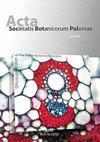滇西北独龙族竹的传统生态知识
IF 0.8
4区 生物学
Q3 PLANT SCIENCES
引用次数: 0
摘要
独龙族长期以来积累了丰富的传统植物学知识(TBK),利用竹子来适应他们的生活环境,这影响了独龙族的生活、文化和创造力的许多方面。然而,关于独龙社区中与竹子相关的TBK的研究仍然缺乏。在独龙社区经济快速发展和社会变化的背景下,调查和记录与竹子有关的TBK是迫在眉睫的。2019年至2020年期间进行了四次实地调查。采用滚雪球抽样法选取30名被调查者,采用免费问卷和半结构化访谈法进行访谈。大多数举报人是或曾经从事竹编采编工作。参与性观察方法也应用于实地调查。利用竹种利用价值(UV)和相对被引频次(RFC)来评价和比较独龙人利用竹类植物的重要性。通过民族生态学调查,记录了独龙族传统使用的7属12种竹和与竹相关的TBK。硫酸盐毛竹(Phyllostachys sulphurea)、福建竹竹(denrocalamus fugongensis)和全竹竹(Fargesia pleniculmis)是最有价值和最受青睐的物种,它们的RFC和UV指数相对较高。独龙江人积累了丰富的与竹有关的TBK,熟悉独龙江地区竹的分布、生态、形态、特征和用途。这些竹植物及其传统知识在保护当地生物多样性和可持续发展方面具有巨大潜力。在未来,我们将增加与竹植物相关的产业,如竹笋食品、竹医药、竹织造工业、竹生物多样性保护等。本文章由计算机程序翻译,如有差异,请以英文原文为准。
Traditional ecological knowledge of bamboo in the Dulong community of northwestern Yunnan, China
The Dulong people have accumulated a wealth of traditional botanical knowledge (TBK) over a long period on bamboo use to adapt to their living environment, which impacts many aspects of the life, culture, and creative productivity of the Dulong people. However, research on TBK associated with bamboo in Dulong communities is still lacking. It is urgent to investigate and document the TBK related to bamboo in the context of rapid economic development and social changes in Dulong communities. Field surveys were conducted four times between 2019 and 2020. Thirty informants were selected using snowball sampling and were interviewed using free lists and semi-structured interviews. Most informants were or had been engaged in bamboo collection and weaving. The participatory observation approach has also been applied to field surveys. The use value (UV) of bamboo species and the relative frequency of citations (RFC) were used to evaluate and compare the importance of bamboo plants used by the Dulong people. Through ethnoecological investigations, 12 bamboo species belonging to seven genera traditionally used by the Dulong people and TBK associated with bamboo were recorded. Phyllostachys sulphurea, Dendrocalamus fugongensis, and Fargesia pleniculmis were the most valuable and favored species, as indicated by their relatively high RFC and UV indices. The Dulong people have accumulated a wealth of TBK associated with bamboo and are familiar with the distribution, ecology, morphology, characteristics, and purpose of bamboo species in the Dulongjiang region. These bamboo plants and their traditional knowledge have great potential for conserving the local biodiversity and sustainable development. In the future, we will increase the growth of industries related to bamboo plants, such as bamboo shoots as food, bamboo as medication, bamboo for the weaving industry, and bamboo for biocultural diversity conservation.
求助全文
通过发布文献求助,成功后即可免费获取论文全文。
去求助
来源期刊
CiteScore
2.00
自引率
10.00%
发文量
18
审稿时长
1 months
期刊介绍:
The journal has been published since 1923 and offers Open Access publication of original research papers, short communications, and reviews in all areas of plant science, including evolution, ecology, genetics, plant structure and development, physiology and biochemistry.

 求助内容:
求助内容: 应助结果提醒方式:
应助结果提醒方式:


